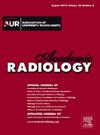前列腺 T2 加权成像中人工智能辅助压缩传感的可行性研究
IF 3.8
2区 医学
Q1 RADIOLOGY, NUCLEAR MEDICINE & MEDICAL IMAGING
引用次数: 0
摘要
理论依据和目标:评估基于人工智能辅助压缩传感(ACS)的前列腺T2加权成像(T2WI)的图像质量和PI-RADS评分性能:在这项前瞻性研究中,成年男性泌尿科门诊或住院患者接受了前列腺 MRI 检查,包括 T2WI、扩散加权成像和表观扩散系数图。采用平行成像(PI)和 ACS 的三种加速扫描方案:通过比较分析评估了 T2WIPI、T2WIACS1 和 T2WIACS2。定量分析包括信噪比(SNR)、对比度与噪声比(CNR)、斜率曲线和边缘上升距离(ERD)。图像质量采用五点李克特量表进行定性评估(从 1 = 无诊断意义到 5 = 非常好)。对每位患者最大或最可疑的病灶进行 PI-RADS 评分。组间比较采用弗里德曼检验和单因素方差分析,并进行事后检验,统计显著性设定为 P 结果:本研究包括 40 名参与者。与PI相比,ACS减少了50%以上的采集时间,显著提高了矢状和轴向T2WI的CNR(P 0.05):ACS将前列腺T2WI采集时间缩短了一半,同时提高了图像质量,且不影响PI-RADS评分。本文章由计算机程序翻译,如有差异,请以英文原文为准。
A Feasibility Study of AI-Assisted Compressed Sensing in Prostate T2-Weighted Imaging
Rationale and Objectives
To evaluate the image quality and PI-RADS scoring performance of prostate T2-weighted imaging (T2WI) based on AI-assisted compressed sensing (ACS).
Materials and Methods
In this prospective study, adult male urological outpatients or inpatients underwent prostate MRI, including T2WI, diffusion-weighted imaging and apparent diffusion coefficient maps. Three accelerated scanning protocols using parallel imaging (PI) and ACS: T2WIPI, T2WIACS1 and T2WIACS2 were evaluated through comparative analysis. Quantitative analysis included signal-to-noise ratio (SNR), contrast-to-noise ratio (CNR), slope profile, and edge rise distance (ERD). Image quality was qualitatively assessed using a five-point Likert scale (ranging from 1 = non-diagnostic to 5 = excellent). PI-RADS scores were determined for the largest or most suspicious lesions in each patient. The Friedman test and one-way ANOVA with post hoc tests were utilized for group comparisons, with statistical significance set at P < 0.05.
Results
This study included 40 participants. Compared to PI, ACS reduced acquisition time by over 50%, significantly enhancing the CNR of sagittal and axial T2WI (P < 0.05), significantly improving the image quality of sagittal and axial T2WI (P < 0.05). No significant differences were observed in slope profile, ERD, and PI-RADS scores between groups (P > 0.05).
Conclusion
ACS reduced prostate T2WI acquisition time by half while improving image quality without affecting PI-RADS scores.
求助全文
通过发布文献求助,成功后即可免费获取论文全文。
去求助
来源期刊

Academic Radiology
医学-核医学
CiteScore
7.60
自引率
10.40%
发文量
432
审稿时长
18 days
期刊介绍:
Academic Radiology publishes original reports of clinical and laboratory investigations in diagnostic imaging, the diagnostic use of radioactive isotopes, computed tomography, positron emission tomography, magnetic resonance imaging, ultrasound, digital subtraction angiography, image-guided interventions and related techniques. It also includes brief technical reports describing original observations, techniques, and instrumental developments; state-of-the-art reports on clinical issues, new technology and other topics of current medical importance; meta-analyses; scientific studies and opinions on radiologic education; and letters to the Editor.
 求助内容:
求助内容: 应助结果提醒方式:
应助结果提醒方式:


